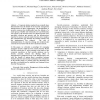Free Online Productivity Tools
i2Speak
i2Symbol
i2OCR
iTex2Img
iWeb2Print
iWeb2Shot
i2Type
iPdf2Split
iPdf2Merge
i2Bopomofo
i2Arabic
i2Style
i2Image
i2PDF
iLatex2Rtf
Sci2ools
BDIM
2007
IEEE
2007
IEEE
Elevating the Discussion on Security Management: The Data Centric Paradigm
— Corporate decision makers have normally been disconnected from the details of the security management infrastructures of their organizations. The management of security resources has traditionally been the domain of a small group of skilled and technically savvy professionals, who report to the executive team. As threats become more prevalent, attackers get smarter and the infrastructure required to secure corporate assets become more complex, the communication gap between the decision makers and the implementers has widened. The risk of misinterpretation of corporate strategy into technical safe controls also increases with the above-mentioned trends. In this paper, we articulate a paradigm for managing enterprise security called the Data Centric Security Model (DCSM), which puts IT policy making in the hands of the corporate executives, so that security decisions can be directly executed without the diluting effect of interpretation at different levels of the infrastructure and w...
| Added | 02 Jun 2010 |
| Updated | 02 Jun 2010 |
| Type | Conference |
| Year | 2007 |
| Where | BDIM |
| Authors | Tyrone Grandison, Marcel Bilger, L. O'Connor, M. Graf, Morton Swimmer, Matthias Schunter, Andreas Wespi, Nev Zunic |
Comments (0)

